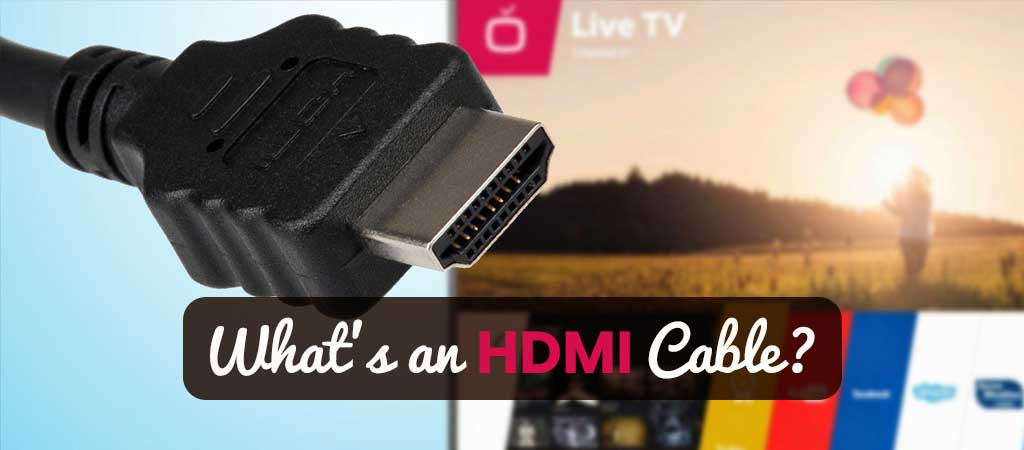What’s an HDmi Cable?
HDMI (High-Definition Multimedia Interface) is not just another cable. With its 19 pins, it bundles the equivalent of 8 audio and 5 video cables into a single cable to meet all home theatre installation requirements. The HDMI cable carries the digital high-definition signal for picture and sound, which also supports “multi-channel” splitting in various formats: Dolby Digital. DTS. DTS HD. DolbyTrue HD. HDMI is compatible with low-definition and has evolved and improved over the years to become the standard for high-definition home theatre transmission.
-
Devices with HDMI inputs or outputs:
The HDMI connection allows you to connect electronic devices that are part of your TV or home theatre installation: Your TV screen (LED or OLED) or video projector, with a Blu-ray or DVD player, or with a cable/satellite box. Many camcorders and HD digital cameras can be connected to a TV via HDMI, as can some PC video cards. Audio and video amplifiers are also connected to the display and audio and video sources via HDMI.
-
Features of HDMI cables
One of the notable contributions of the HDMI standard is the ability to transmit additional information in both directions in parallel with the audio/video signal. For example, the OSD (on-screen display): If the menu of your home theater amplifier or Blu-ray player automatically appears on your flat screen where you make your settings, it’s thanks to HDMI!
The same principle applies to CEC (Consumer Electronic Control): with a simple touch of the remote, you can program all the devices in your AV system to activate simultaneously. Perfect for turning all your devices on or off…. You can also pre-configure your system so that the play button on your Blu-ray player’s remote will start the movie, switch your TV to the correct channel with the correct aspect ratio, and switch your A/V amplifier to the correct source. Of course, this assumes CEC compatibility of all devices, which may be called different things depending on the brand (Viera Link from Panasonic, AnyNet+ from Samsung, Regza Link from Toshiba, etc.).
Placed between your flat screen and the sources to which it is connected via HDMI, your AV receiver can be “neutralized” for certain applications thanks to the pass-through function. For example: you want to watch a DVD documentary without using the power of your home theater amplifier, but only the sound of your TV? Then you can “pass through” the HDMI signal through the home theater amplifier in standby mode without it blocking the transmission of picture and sound to your TV.
-
Why the TV does not support the image on laptop via HDMI?
Nowadays, anyone using an HDMI cable can connect a laptop or desktop computer to a flat-screen LCD TV and enjoy the magnified image. This connection is not always successful: for example, no sound can be heard. However, there are cases when the computer does not recognize the TV connected via HDMI at all, even if the cable was just purchased in the store where the multiple tests were performed. Cable malfunctions can have various causes, and the search for a real problem must be carried out consistently.
[/et_pb_text][et_pb_cta title=”Check our Subscriptions” button_url=”@ET-DC@eyJkeW5hbWljIjp0cnVlLCJjb250ZW50IjoicG9zdF9saW5rX3VybF9wYWdlIiwic2V0dGluZ3MiOnsicG9zdF9pZCI6IjExNCJ9fQ==@” button_text=”Here” _builder_version=”4.17.4″ _dynamic_attributes=”button_url” _module_preset=”default” header_font=”Montserrat|600||on|||||” header_text_align=”center” header_font_size=”30px” background_color=”#EC2971″ background_image=”https://iptvlit.com/wp-content/uploads/2021/10/iptv-lit-bg-3.jpg” parallax=”on” parallax_method=”off” background_enable_pattern_style=”on” background_pattern_style=”smiles” background_pattern_color=”rgba(0,0,0,0.34)” custom_button=”on” header_text_shadow_style=”preset3″ header_text_shadow_color=”#000000″ border_radii=”off|||60px|” box_shadow_style=”preset3″ global_colors_info=”{}”][/et_pb_cta][et_pb_text _builder_version=”4.17.4″ _module_preset=”default” text_font=”Poppins|300|||||||” header_2_font=”|||on|||||” header_2_text_color=”#EF4555″ custom_margin=”57px|||||” global_colors_info=”{}”]What to do if the TV does not recognize the laptop via HDMI?
The video cards of all modern products support this connection: If the laptop has been connected by all the rules of the art, but still no picture can be seen, connect the laptop to the TV and systematically check all possible problems.
-
1-Check the cable
No product, not even the most reliable brand, is immune from manufacturing defects, especially in manual installation. When buying, we check the picture and sound quality, but we never check the TV-specific connectors and jacks. At best, their presence is certified, and even then, not all buyers are satisfied. It often happens that the cable itself does not work, even if it has not been used for a long time. Connect the same cable to another device; if it works normally, it means that the computer does not see the TV. To detect similar signals, it is necessary to diagnose the TV.
-
2-Check the signal source
Press the button on the remote control to select the external input option. It depends on the product model. Press the button on the TV remote control: “Source”, “Input” or “HDMI” (LG, Sony or Samsung) After pressing on the screen, a menu with detailed information will appear. Select the desired input to which the handset cable is already connected and confirm with OK or Enter.
-
3-Working with the monitor
If the handset does not show the TV’s screen when several monitors are connected at the same time, advanced settings must be made. These simple manipulations can be done by any user without special training:
- Move the cursor to any free space on the desktop
- Right-click to display the menu
- Find the section “Screen resolution” – Windows 7, and if Windows XP costs, then “Graphics functions”
- And then choose an acceptable option to duplicate the screen.


Recent Comments